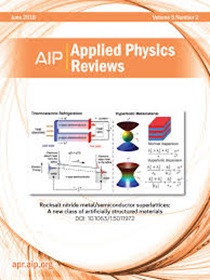The physics of phase transition phenomena enhanced by nanoparticles
IF 11.9
1区 物理与天体物理
Q1 PHYSICS, APPLIED
引用次数: 0
Abstract
Phase transitions are fundamental phenomena in physics that have been extensively studied owing to their applications across diverse industrial sectors, including energy, power, healthcare, and the environment. An example of such applications in the energy sector is thermal energy storage using phase change materials. In such systems, and indeed in many other thermal systems, an emerging and promising approach involves the use of nanoparticles, which have been extensively studied for their potential to enhance the performance of thermal systems. However, conducting thermodynamic analyses of thermal systems in the presence of nanoparticles proves to be complex and resource-consuming because of the involvement of many parameters, including (i) temperature, molecular structure, and composition of the host fluid in which nanoparticles are either dispersed or in physical contact; (ii) nanoparticle morphology, size, type, and concentration; and (iii) complex interactions between the nanoparticles and the base fluid. This article reviews recent studies on the role of nanoparticles in phase transition processes such as freezing, melting, boiling, evaporation, and condensation. It begins with an overview of phase transition phenomena without nanoparticles, emphasizing the most important controlling parameters, and then examines the underlying physics of nanoparticle-involved phase transitions, critically examining their impact on process speed (transport rates). The article also explores physical phenomena, such as Brownian motion, thermophoresis, microconvection, and nanoparticle agglomeration, and considers their contribution to rate control (enhancement or reduction). Finally, the article presents challenges, research gaps, and suggestions for future exploration, aimed at offering a comprehensive understanding of the complex interplay between the presence of nanoparticles and the phase transition processes.纳米颗粒增强相变现象的物理学
相变是物理学中的基本现象,由于其在不同工业部门(包括能源、电力、医疗保健和环境)的应用,已被广泛研究。这种应用在能源领域的一个例子是使用相变材料的热能储存。在这样的系统中,实际上在许多其他的热系统中,一种新兴的和有前途的方法涉及到纳米颗粒的使用,纳米颗粒因其增强热系统性能的潜力而被广泛研究。然而,在纳米颗粒存在的情况下,对热系统进行热力学分析被证明是复杂和消耗资源的,因为涉及许多参数,包括(i)温度、分子结构和纳米颗粒分散或物理接触的宿主流体的组成;(ii)纳米颗粒的形态、大小、类型和浓度;(三)纳米颗粒与基液之间复杂的相互作用。本文综述了纳米颗粒在冻结、熔化、沸腾、蒸发和冷凝等相变过程中的作用。它首先概述了没有纳米颗粒的相变现象,强调最重要的控制参数,然后检查纳米颗粒涉及相变的潜在物理,严格检查它们对过程速度(传输速率)的影响。文章还探讨了物理现象,如布朗运动、热泳动、微对流和纳米颗粒团聚,并考虑了它们对速率控制(增强或降低)的贡献。最后,本文提出了挑战、研究差距和对未来探索的建议,旨在全面了解纳米颗粒的存在与相变过程之间复杂的相互作用。
本文章由计算机程序翻译,如有差异,请以英文原文为准。
求助全文
约1分钟内获得全文
求助全文
来源期刊

Applied physics reviews
PHYSICS, APPLIED-
CiteScore
22.50
自引率
2.00%
发文量
113
审稿时长
2 months
期刊介绍:
Applied Physics Reviews (APR) is a journal featuring articles on critical topics in experimental or theoretical research in applied physics and applications of physics to other scientific and engineering branches. The publication includes two main types of articles:
Original Research: These articles report on high-quality, novel research studies that are of significant interest to the applied physics community.
Reviews: Review articles in APR can either be authoritative and comprehensive assessments of established areas of applied physics or short, timely reviews of recent advances in established fields or emerging areas of applied physics.
 求助内容:
求助内容: 应助结果提醒方式:
应助结果提醒方式:


